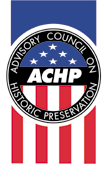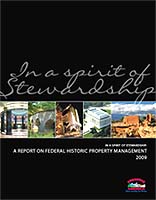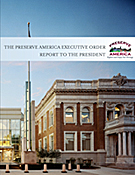 About
ACHP
About
ACHP ACHP News
National Historic
Preservation
Program
Working with
Section 106
Federal, State, & Tribal Programs
Training & Education
Publications
Search
Home
Section 3: Improving Federal Agency Planning and Accountability
Executive Order 13287 (EO 13287), Preserve America, issued on March 3, 2003, was a defining moment in the federal stewardship of historic property. Rather than continuing to consider all real property holdings in a similar manner, agencies were required to recognize that federal historic properties are valuable assets that can support agency missions and also stimulate local economic development. Agencies have long acknowledged that their real property inventory generally includes historic properties that are important to the nation as well as the agency. Nevertheless, each agency approaches its oversight and management of historic properties differently based upon budgetary, program, and management considerations. While many agencies have made the preservation and protection of historic properties a priority, others face daunting challenges given the sheer volume of their historic property inventory and recent changes in agency mission.
Section 3 of EO 13287 establishes an accountability system to gauge agency implementation of the mandates of the National Historic Preservation Act (NHPA) and the EO. Accurate information on the state of federally owned historic properties is essential to achieving the goals of the EO and to promoting community economic development through local partnerships.
In 2004, each federal agency with real property management responsibilities (Section 3(a) and (b)) were to prepare an assessment of the current status of its inventory of historic properties required by Section 110(a)(2) of the NHPA (16 U.S.C. 470h-2(a)(2)), the general condition and management of needs of such properties, and the steps underway or planned to meet those management needs. These assessments were also to include an evaluation of the suitability of the agency’s types of historic properties to contribute to community economic development initiatives, including heritage tourism, taking into account agency mission needs, public access considerations, and the long-term preservation of the historic properties. In reviewing their regulations, management policies, and operating procedures for compliance with Sections 110 and 111 of the NHPA (16 U.S.C. 470h-2 and 470h-3), agencies with real property management responsibilities made these results available to the ACHP and the Secretary of the Interior. Since the initial reporting in 2004, real property managing agencies have been submitting triennial progress reports to the ACHP for the identification, protection, and use of historic properties within their real property inventory.
![]() Click here to view a list of agencies that submitted a 2004 baseline report.
Click here to view a list of agencies that submitted a 2004 baseline report.
Section 3 of EO 13287 requires that agencies with real property management responsibilities report every three years on progress in the identification, protection, and use of historic properties in federal ownership and make this report also available to the ACHP and the Secretary of the Interior.
![]() Click here to view a list of agencies who submitted a progress report.
Click here to view a list of agencies who submitted a progress report.
The ACHP then incorporates the received data into a report on the state of the federal government’s historic properties and their contribution to local economic development that is submitted to the President starting in 2006 and every three years thereafter.
View the following ACHP reports to the President:
 |
2009 Report to the President |
 |
2006 Report to the President |
In 2007, the ACHP reconvened its Advisory Guidelines Working Group with a cross section of federal agencies: land managing, assistance, large, and small. With assistance from this working group, the ACHP published its revised Section 3: Reporting Progress on the Identification, Protection, and Use of Federal Historic Properties with the following objectives:
- Provide increased focus on the need to report progress in the identification, protection, and use of historic properties as required by Section 3(c) of the EO;
- Solicit information from agencies on their efforts to establish and meet benchmarks for the improvement of their preservation efforts and programs and to identify successes and challenges in incorporating these goals into agency strategic plans;
- Provide guidance to agencies on coordinating the preparation of Section 3 progress reports with other federal agency reporting responsibilities and encourage greater coordination within agencies between preservation staff who are completing Section 3 progress reports and staff in other programs who may be completing other reports that account for similar activities; and
- Provide a lasting framework for future progress reports to be updated only as needed.
The 2003 advisory guidelines as directed by Section 3(d) of EO 13287, were published by the ACHP to assist federal agencies with real property management responsibilities in preparing the baseline report for 2004 and the first progress report in 2005.
- What is the purpose of my agency submitting a Section 3 Report?
- How do the requirements of Section 3 of EO 13287 relate to those of Section 110 of the NHPA?
- Are certain agencies exempt from the requirement to prepare a Section 3 Progress Report?
- For the purposes of the EO, how are "historic properties" defined?
- Are agencies required to include their Section 3 Progress Report property they lease or manage under contractual arrangements with another agency?
- What level of detail does the ACHP expect agencies to provide with regard to the conditions of their historic properties?
- Should agencies coordinate the Section 3 Progress Report with any other government-wide real property reports required of federal agencies?
- Who should transmit the Section 3 Progress Report to the ACHP and Department of the Interior?
- In what format should the Section 3 Progress Report be submitted and how many copies are required?
- Will my agency’s progress report be posted to the ACHP’s Web site?
1. What is the purpose of my agency submitting a Section 3 Report?
President Bush issued EO 13287 to reaffirm the federal government's commitment to providing leadership in preserving America's heritage by improving the stewardship of federal real property. EO 13287 includes a number of actions that are intended to encourage better accounting, use, management, and recognition of historic properties under the ownership of the agency. By preparing the Section 3 reports, agencies will increase their knowledge of their historic properties and determine how to best protect and manage such properties as assets. In addition, the information contained in the reports will enable the ACHP and the Department of Interior to better advise Congress and the President regarding issues related to federal property stewardship.
2. How do the requirements of Section 3 of EO 13287 relate to those of Section 110 of the National Historic Preservation Act?
Section 3 of the EO 13287 "Improving Federal Agency Planning and Accountability," is not intended to replace the requirements of Section 110 of the NHPA. Rather, Section 3 is intended to assess how federal agencies are meeting their Section 110 responsibilities and determine whether they have developed sound management and operating policies to protect, preserve, and use federally owned historic properties.
3. Are certain agencies exempt from the requirement to prepare a Section 3 Progress Report?
The EO applies to all Executive Branch departments and agencies. However, Section 3 of the EO applies specifically to such departments and agencies that have real property management responsibilities.
4. For the purposes of the EO, how are "historic properties" defined?
As set forth in Section 7 of the EO, the applicable definition of “historic properties” is the one found in the NHPA. Under that definition a "historic property" is "any prehistoric or historic district, site, building, structure, or object included in or eligible for inclusion in the National Register, including artifacts, records, and material remains related to such a property or resource (16 U.S.C. 470w(5)).”
5. Are agencies required to include in their Section 3 Progress Report property they lease or manage under contractual arrangements with another agency?
Section 110(a)(2)(A) requires each federal agency to develop a preservation program for historic properties under the jurisdiction or control of the agency. The agency that leases or manages a historic property under an arrangement with another agency should contact the agency owning the property to clarify that the property will be reported as an out leased or co-managed property in its inventory of historic properties. However, it is acceptable for each agency to include such property in its Section 3 Progress Report as long as the agency specifies whether it is the lessor and lessee.
6. What level of detail does the ACHP expect agencies to provide with regard to the conditions of their historic properties?
Section 3 Progress Reports should include information on the general condition of properties in the federal agency's historic inventory. Since each agency has its own protocols for assessing the condition of its real property, in the initial report the ACHP would like to know the methodology for evaluating the conditions of properties, the qualifications of the staff making these assessments, and the schedule for evaluating current conditions of properties. A particularly important issue that should be addressed in the report is whether buildings are in poor condition due to neglect, sustained vacancies, or a pattern of deferred maintenance.
7. Should agencies coordinate the Section 3 Progress Report with any other government-wide real property reports required of federal agencies?
Some of the information required for the Section 3 Progress Report may be the same as that used in compiling the Federal Accounting Standards Advisory Board reports. Presently, agencies are required to report descriptive, non-financial information on stewardship land and heritage assets in accordance with the Statement of Federal Financial Accounting Standards (SFFAS) No. 29. While in the past this information was not auditable, changes have been made to require auditors to provide examination level assurance regarding these reports. Therefore, agencies may be able to use some of the information collected for its heritage assets report (SFFAS No. 29) when it is consistent with the requirements of Section 3.
8. Who should transmit the Section 3 Progress Report to the ACHP and Department of the lnterior?
Section 3 Progress Reports should be submitted to the ACHP by the head of the agency, or his/her designee, to ensure that the reports are reviewed and endorsed by the agency's senior policy officials.
9. In what format should the Section 3 Progress Report be submitted and how many copies are required?
Federal agencies are not required to structure their Section 3 progress report in response to the advisory guideline’s questions. These advisory guidelines are for a federal agency’s consideration only and allow agencies to use these advisory guidelines in conjunction with established agency reporting formats. Should an agency choose to format its report in response to these questions, that agency may choose to answer questions singularly or through a combined response to multiple questions as it sees fit.
Agencies are encouraged to include with their report data, case studies, best practices, and Web sites that explain their responses. When submitting these examples please clarify the role of state and local governments, tribes, civic or community organizations, and the private sector as appropriate. If various funding sources were used to establish a partnership, agencies are encouraged to identify the sources of public and private funding.
Please submit two hard copies, including an electronic copy as a PDF file or a Microsoft Word document with graphics meeting a 500 DPI minimum (ultra high resolution is preferred), no later than September 30, 2005, and every three years there after, to the following address:
Chairman
Advisory Council on Historic Preservation
ATTN: Section 3 Progress Report
1100 Pennsylvania Avenue, NW
Room 803
Washington, DC 20004-2501
10. Will my agency’s progress report be posted to the ACHP’s Web site?
The ACHP will make Section 3 reports available on its Web site. Departments and agencies with security concerns may submit an executive summary to post on the ACHP Web site in lieu of the entire progress report. In this situation a full report must still be submitted to the ACHP for review.
Updated February 25, 2009